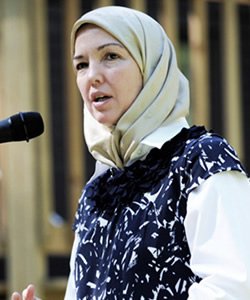The metaphor of “the path” is widespread among religious traditions, a fact that is acknowledged by the Qur’an (5:48) when it says, “For each community We have established paths and roads.” The Jewish halakha and Islamic sharia both mean “the way” that will lead toward the divine. In each cycle of ritual prayer Muslims pray, “Guide us to the straight path.” A legal school—of which there are many in Islam—is called a madhab while the countless Sufi schools of spiritual practice are known as tariqa—both words mean “a path.”
The diversity of paths mentioned raises the question of whether all ways lead to God. This is a deep and contested theological and metaphysical issue. What is seldom disputed among mainstream Muslims is that there are a number of diverse paths that weave in and out amongst each other but are all directed toward the same destination. Most importantly, guidance to the path belongs to God; the Qur’an (28:56) says, “You do not guide whom you like, rather it is God who guides whom He wills -.” A Muslim leader should never think of him or herself as a guide who has the authority to force anyone off or on the path they are on themselves. Our most important job is to help those whom God guides to the path but who find their way blocked. In this regard, my theology of religious leadership has been informed by the reported teaching of the Prophet Muhammad, which states, “Removing harmful things from the road is an act of charity.” Helping others by removing obstacles that block their path to God is at the heart of religious leadership.
What can block the path of a believer? All too often it is people from one’s own community who have put up illegal roadblocks. These vigilantes of religion claim they have the authority to prevent others from moving forward. Many times I have heard from students or women’s groups that they began a community project only to be told by these self-appointed religious police that they were “not allowed” to speak or act in one fashion or another. My responsibility is to deconstruct the authority of these claims and to demonstrate the structural flaws in the barriers they have erected. What I have to offer is knowledge of Islamic history, theology, and ethics—as well as logic and legal disputation—to show that the road is wide and if they cannot take down the barriers, sometimes they can just walk around them and remain headed in the right direction.
People can be diverted and distracted from moving forward by loud and disturbing events. They become frozen with fear or fascination and stop moving completely. The role of the leader is to put the distraction into perspective and draw people’s attention back to the path. An Arabic proverb says, “The dogs bark but the caravan moves on.” In these situations, my role is to remind people to give proper attention to threats, but not to become paralyzed by them. In concrete terms, this often means paying less attention to a social media troll or the latest loud-mouthed self-styled expert on the news, and more on one’s spiritual and educational goals, the needs of one’s family, and community building.
The best thing a leader can do is to equip others with to clear the path themselves. Many religious leaders and teachers engender dependency in those who have come to them for help. This is a complex process, because the relationship is often initiated by those who are so disempowered that they have no confidence in their own abilities. What they seek is a father or mother figure to carry them forward. The confidence and admiration they have in the religious leader is flattering. This is where one’s sincerity is tested. A religious leader’s goal should not be to attract “followers” but to help others build up their strength and learn how to move ahead. Certainly there will always be particularly treacherous places along the way that require specialized training; these include deep trauma, breach of trust in families, and making decisions on complex ethical issues. The religious leader should be on call to help resolve these harmful situations, but then should step aside to allow people continue along their way.
Some people have asked me if men and women have or should have different leadership styles. This has led me to reflect upon the differences in the way Muslim men and women are taught to lead group prayer: a man stands in front of the men he leads, while a woman stands in the center of the women she leads. Is women’s leadership more collaborative? Is it more effective if the woman stands out less? Do men need more hierarchy in leadership? I don’t think the model of prayer necessarily reflects the reality or ideal of leadership in all areas of life. The male and female leaders I know are diverse—some encouraging and leading humbly, almost from behind, others flash and glitter, lighting the way like torches on a dark night. God has given us different personalities and skills because our needs vary according to the ever-changing circumstances of our lives.
All leaders at their core have a deep, natural impulse to intervene when they see something wrong or notice an opportunity for improvement. But without knowledge and skills, such people can be nothing more than agitators or busybodies. Without humility and an awareness of their own limits, such people can end up as demagogues or bullies. But none of us can see who we are without looking in the mirror. The Prophet Muhammad said “A believer is a mirror to a believer,” so a leader who does not want to become a pothole in the path of others needs to seek, and heed, plenty of feedback.

